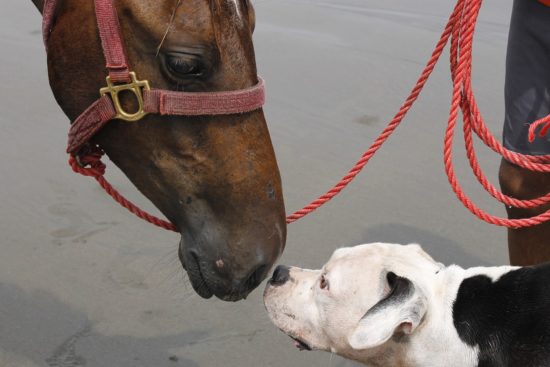
(Thanks to Charlie and Chris for the pic of Tiny.)
If you haven’t read the first two parts of this series on pit bull awareness, I invite you to do that.
Part 1 provided a brief glimpse at the different breeds that make up the pit bull family and their history.
Part 2 examined dog bite statistics, how pit bulls are often misidentified, and the role of genetics in behavior of dogs.
In this last section we’ll look at the role of environment and life experience on behavior, public policy recommendations by various groups to maximize public safety and minimize dog bites, and finally take another look at the pit bull.
So We’re Back to Learned Behavior and Environment Once Again.
There are many, many things that affect a dog’s behavior and stress level beyond their genes. Some examples might be:
- Health issues (infections, parasites, disease, pain, etc.).
- Availability and quality of food and water (reliable scheduled feedings of decent food – or haphazard feedings of poor food alternating with periods of hunger).
- Relationship with significant humans (loving family – or abuse and neglect).
- Education from mother and litter mates (incomplete if removed earlier than 8 weeks of life).
- Socialization and exposure to new things at appropriate times in the first 16 weeks of life (when the brain is still actively growing).
- Insufficient exercise or mental stimulation (in essence, boredom).
This list is not intended to be exhaustive or complete – only to show a sampling of how environment and previous or current experience would play a huge role in behavior. Any dog of any breed can bite out of fear or pain – or from over- or under-stimulation. They can bite in defense of “their” territory or possessions. But dogs will not bite without exhibiting some type of warning signs beforehand.
Brambell’s “Five Freedoms.”
The Brambell Commission was created by Parliament in Great Britain in 1965 to define an animal’s most basic needs (what a sad commentary that this should be necessary at all). Although the commission was created to define humane treatment of farm animals, their findings apply equally to our dogs – and to people for that matter. Their “Five Freedoms” include the following:
- Freedom from hunger, thirst and malnutrition.
- Freedom from discomfort.
- Freedom from pain, injury and disease.
- Freedom to express normal behaviors.
- Freedom from fear and distress.
Any situation outside of these five freedoms was felt by that commission to generate stress and distress to the animal – and could then by extension result in abnormal behavior. The article here (Understanding, Identifying and Coping with Canine Stress) by Green Acres Kennel explores this further as it relates to dogs.
Karen Overall of the Center for Neurobiology and Behavior at the University of Pennsylvania has indeed reported higher cortisol (stress hormone) and lower levels of serotonin and dopamine (happy hormones) in aggressive dogs (Why Does My Dog Act That Way: A Complete Guide To Your Dog’s Personality), as would be expected.
Pet Behaviorist.

(Photo by TC-Torres on Pixabay under CC0.)
Stanley Coren in his book (Why Does My Dog Act That Way: A Complete Guide to Your Dog’s Personality) states:
“Ignorance of proper rearing and socialization practices is sad, but it is sadder still that some people deliberately manipulate dogs to make them vicious and dangerous.”
When talking about dogs used for fighting, he says that they lack:
“normal social responsiveness that makes them normal pack animals.”
Dog Trainers.
Cesar Millan.
One of Cesar most well known quotes is:
“There is no such thing as a problem breed. However, there is no shortage of ‘problem owners’ …”
He has an article on his site about pit bulls and why he loves them here. The In it he states that:
“A pit bull is no more likely to unpredictably attack than any other breed.”
This article also includes some of his thoughts on exercise and training of these dogs.
Victoria Stilwell.
Victoria Stilwell, renowned trainer, feels that:
“The myth that pit bulls are dangerous and bred to be violent is simply not true.”
and
“The way a dog is raised and the environment in which he is raised has a significant impact on behavior, regardless of breed.”
Her article, The Truth About Pit Bulls, can be found here.
American Temperament Test Society, Inc.
The American Temperament Test Society (ATTS) is a not-for-profit organization for promotion of a uniform temperament evaluation for all dogs. It has a 10-point test of temperament rather than behavior or training. This test simulates an everyday walk while encountering various unexpected things along the way. A recorded video of one such test can be found here. The dog is graded on reaction to these unexpected encounters by three separate examiners, with majority dictating pass or fail. According to their statistics as of April 2016, the American Pit Bull Terrier has an 87.4% pass rate on these tests. You can see the pass/fail rate for all breeds here.
Public Policy Recommendations.

(Photo by Crazypitbull on Pixabay under CC0.)
A number of organizations have made public policy recommendations going forward for protection of the public from vicious dogs.
The Humane Society of the United States.
The Humane Society of the United States (HSUS) says:
“Neither science nor statistics support policies that discriminate based on breed or physical appearance.”
They have put together a page here explaining their position on breed specific legislation (BSL), as well as that of other organizations including the Center for Disease Control and Prevention (CDC), the American Veterinary Medical Association (AVMA), and even that of President Obama’s administration, the American Kennel Club and other organizations. I strongly urge you to take the time to read through this page.
The Center for Disease Control and Prevention.
The Center for Disease Control and Prevention (CDC) says of breed specific legislation (BSL):
“Fatal attacks represent a small proportion of dog bite injuries to humans and, therefore, should not be the primary factor driving public policy concerning dangerous dogs.”
Their 20-year report of dog-bite fatalities can be found in Part 2 of this series, as well as a number of relevant studies by AVMA.
American Society for the Prevention of Cruelty to Animals.
The American Society for the Prevention of Cruelty to Animals (ASPCA) has asked that their statement be taken in its entirety rather than quoted. I have linked to it here.
The Animal Cruelty Taskforce of Ohio.
Steffen Baldwin of the Animal Cruelty Taskforce of Ohio (ACT), again writing for the Huffington Post, advocates for more resources for animal control:
“I believe we can do better as a society for the animals entrusted in our care and I see the biggest opportunity, with those who have their boots on the ground doing the job already. “
You can read his suggestions for protection of pit bulls (and other abused animals) here.
None of the recommendations above favor BSL as a means of public protection. All of them focus rather on further education, adequate training and supervision of dogs, increased resources for animal control, and keeping owners responsible, including making more resources available for low cost neutering and spaying programs. These recommendations are not singling out pit bull or any other type dogs, but rather all dogs, and providing the resources that will enable animal control specialists to do their job more effectively.
One of the strategies that I personally had not heard before was that of educating children on avoiding dog bites. If only 44% of American families include a dog (see Start the Search For Your Next Family Member – Adopt), that leaves many children who may very well have never had any real conversations or teaching on that topic. I love that idea!
Thanks to i sentimenti che non rispecchiano lo squardo … on YouTube for this video.
So That Brings Us Full Circle Again to the Beginning …
There are an estimated 78.2 million dogs in the United States, approximately 3.91 million of which are “pit bulls.”
Pit bull myths.
- They have locking jaws. NOT TRUE. Their anatomy – and the pressure of their bite – is the same as every other dog.
- They give no warning signs before they bite. NOT TRUE. The same warning signs are there as for every other dog.
Pit bull truths.
- Most weigh between 55 and 70 pounds.
- They are energetic, athletic and love to play – and need plenty of exercise.
- Pit bulls are very intelligent and can be escape artists – especially if bored.
- They love people, are loyal and bond deeply to their families.
- They enjoy being the center of attention.
- The pit bull perseveres cheerfully in spite of adversity, unfortunately a very sad necessity for them with their history.

(Photo by TC-Torres on Pixabay under CC0.)
According to Victoria Stilwell, pit bulls:
“enjoy a zest for life that is often incomparable to others.”
and
“tend to be highly demonstrative and emotional dogs that think with their hearts rather than their heads.”
Caroline Coili, Ph.D., describes them as:
“an uncanny canine combination of fun, foolishness, and serious business, all wrapped up in love”
and claims they are
“more likely to maul a burgler by licking him to death than by attacking him.”
Krissi Tober-Fussner, CEO of Mercy’s Door in Savannah, Ohio wishes:
“I pray one day “pit bulls” are called a dog just like every other dog out there.”
Maybe that wish has been answered.
Dr. Karen Overall, veterinary behaviorist and researcher in the Department of Psychiatry at The University of Pennsylvania School of Medicine in Philadelphia, based on her genetic research says:
“It turns out that pit bulls are, in fact, absolutely the same as all dogs.”
Unless I’ve missed my guess completely, there are many, many pit bull families that would beg to differ – telling her that they are much better than every other dog out there …
Thanks to Kayla Watkins for this video on YouTube.
Final Thoughts.
This was not intended to be such a long article. Thanks so much for those of you still with me here – we have finally reached the end!
This was an attempt to explore why these dogs are so controversial – and it seems to me that all of these pieces were necessary for a full picture to be drawn. In part 1, we very briefly explored the different breeds that make up the “pit bull” family and their history – both remote and recent. In part 2, we looked at many ugly statistics – and also the fact that most of these statistics are based on media reports. We also looked at how difficult it is to actually identify a member of the “pit bull” family, even by professionals. We then looked at the role of genetics in dog behavior, since that is a primary argument for the attempted extermination of this family of dog. In this final section, we’ve looked at the role that environmental factors play in behavior, recommendations by the experts for public policy for vicious dogs going forward, a few pit bull myths and some pit bull truths.
I had no intention of stating any opinion at the end of this – but rather to leave you to mull things over and decide for yourself what you think of the pit bull family of dogs. That intent changed when I realized how many communities still have archaic BSL in place and how many wonderful dogs are being euthanized because of their appearance. And I thought it was a bit of a cop-out on my part.
So here’s my two-cents-worth. I’ve never had the pleasure of owning a pit bull – even though I have been asked in the past why I have two of them (one a fully papered yellow lab and the other a German shepherd/boxer mix) – so they are apparently misidentified frequently. I have several friends who would never have any other type of dog – and several more with kids who have been bitten by “pit bulls” (neither serious bites, fortunately).
Thanks to Mydogsbook for this video on YouTube.
After going through all this information, I do feel that education on dog bite avoidance is critical. I think there is far too much money being spent on tracking down and eliminating many dogs with responsible owners who have done nothing wrong. That money could be much better spent providing humane officers with the resources and staff they need to do their job effectively.
BSL (in my opinion) is essentially the equivalent of racial profiling. It’s not effective – and definitely not an ethical way to approach any problem. Under the right circumstances, any dog will bite. Should we eliminate all dogs then? Or all dogs above the weight of 40 pounds? Where do we stop?
We should go to the experts (of which I am not one!) for the answers. Read their opinions and suggestions above and decide what makes sense and feels right to you. This system is broken – and people are still suffering from dog bites. Let’s fix it together – in an ethical and humane manner that protects people from vicious dogs and allows pit bull families to enjoy each other in peace.
I realize I haven’t given anyone much opportunity to state their thoughts – sorry, it has been a very long monologue.
Do you have a pit bull? Any pit bull stories? Any thoughts on keeping our communities safe? I would love any polite comments and discussion.
A special thank you to the above-mentioned photographers and creatives for making their work available for use.
My sources for this article are listed below for further reading.
Sources/Further Reading.
https://justsimplydogs.com/2016/10/pit-bull-awareness-part-1-pit-bull-breeds-and-history/
http://www.greenacreskennel.com/dog-behavior-and-training/understanding-canine-stress
Coren, Stanley (2006). Why Does My Dog Act That Way: A Complete Guide to Your Dog’s Personality. New York, New York: Free Press.
https://www.cesarsway.com/cesar-millan/cesars-blog/why-I-love-pit-bulls
https://positively.com/Victoria’sblog/the-truth-about-pit-bulls/
http://atts.org/2013/01/atts-test-video/
http://atts.org/breed-statistics/
http://www.aspca.org/about-us/aspca-policy-and-position-statements/position-statement-pit-bulls
https://justsimplydogs.com/2016/11/start-the-search-for-your-next-family-member-adopt/
Coile, D. Caroline, Ph.D. (2001). Pit Bulls for Dummies. Indianapolis, Indiana: Wiley Publishing, Inc.
O’Neil, Jacqueline (1995). The American Pit Bull Terrier: An Owners Guide to a Happy Healthy Pet. Nashville, Tennessee: Howell Book House.
http://www.mercysdoorpetrescue.org/index.html
http://www.Stevedalepetworld.com/one-expert-stands-alone-pit-bulls/
Like this? Share it!
